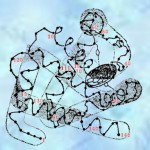Generally speaking, protein engineering can be described as the the second genetic engineering that is based on genetic analyses. It meets the demands of people on industrial production and daily life by modifying the existing proteins or creating a new protein, on the basis of protein molecules’ structural law and biological functions. In fact, there is still another kind of concept about such issue. Protein engineering is to obtain some important information of proteins’ physicochemical properties and molecular characteristics through studying protein chemistry, protein crystallography and protein dynamics. In addition, in terms of this unique basis, purposeful design and transformation on encoded proteins’ gene can be helpful in receiving the transgenic biological systems. These biological systems might be transgenic microorganisms, transgenic plants, transgenic animals, or even cell systems.
 In principle, genetic engineering can only produce the existing proteins in nature. Their structures and functions might be in accordance with the needs of particular species’ survival, but not fully meet the increasing requirements of people’s daily life, as well as the industrial production. For example, interferon, a synthetic protein in animals, can be used for the treatment of viral infections and cancers. However, the vitro preservation is pretty difficult. If a serine on its molecules could be changed into the cysteine, then such interferon might be kept for half of a year at 70℃, which will bring more practical benefits for the majority of patients.
In principle, genetic engineering can only produce the existing proteins in nature. Their structures and functions might be in accordance with the needs of particular species’ survival, but not fully meet the increasing requirements of people’s daily life, as well as the industrial production. For example, interferon, a synthetic protein in animals, can be used for the treatment of viral infections and cancers. However, the vitro preservation is pretty difficult. If a serine on its molecules could be changed into the cysteine, then such interferon might be kept for half of a year at 70℃, which will bring more practical benefits for the majority of patients.
One of the core content of protein engineering is to collect a large amount of information relevant to proteins’ molecular structures, merely for the purpose of establishing a database between the structures and functions and then laying a foundation for the theoretical study of the unique relationship. Taking into account of the research status, proteins’ new structures have changed the necessary tools of original biological functions. Moreover, the technology in crystallography has made great contributions in determining proteins’ structures while there is still a obvious shortcoming, namely the difficulty of separating sufficient amounts of pure proteins. Furthermore, as for proteins, their crystalline state is different from the natural state, which requires more attention while conducting analysis.
In brief, protein engineering is regarded as a molecule engineering that has developed rapidly. It can modify the catalytic activity of enzyme, thermal denaturation, and so on. Generally speaking, protein engineering displays the latest achievements of contemporary molecular biology and other disciplines, which will promote the research upon proteins and enzyme to a new era.
